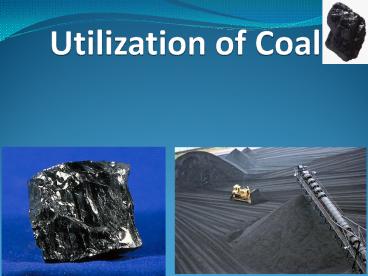Utilization of Coal - PowerPoint PPT Presentation
Title:
Utilization of Coal
Description:
* * * * * * * * * * * * * * * * * * * * * * * * * * * * * During the seventies and also in eighties,, it appeared that conventional pulverised coal-fired power plants ... – PowerPoint PPT presentation
Number of Views:224
Avg rating:3.0/5.0
Title: Utilization of Coal
1
Utilization of Coal
2
Using Coal
- Used for heating as early as the time of cavemen
and by the Romans in 100-200 A.D.
3
Other Uses of Coal Today
- Gasification or Hydroliquefaction blasting coal
with steam to produce Carbon Monoxide and
Hydrogen gas.
The Piñon Pine plant near Reno, Nevada. Converts
Coal into Hydrogen gas.
4
Early Commercial Coal Burning
5
Early 1800s Commercial Coal Burning Uses
- Saltmaking- Coal-fired steam boilers used to
separate salt from brine. - Iron Industry - Coal used for heating iron ore
and to make Coke - Steam engines- used to drive machinery at
flouring mills, gristmills, rolling mills,
breweries, glass manufactories, and nail
factories. Also used in trains and steamships.
6
The Salt making Industry
- In 1825
- Over 200,000 tons of coal per year were being
used by the salt industry to produce salt for
domestic consumption. - By 1830
- Had become a major industry in Armstrong and
Indiana Counties in western Pennsylvania. - 24 salt wells dug, producing 65,000 tons of salt.
- From 1815-1870
- 100,000 tons of bituminous coal consumed
annually by the salt making industry.
7
Coal-Fired Steam Boilers
8
The Iron Industry
- The problem
- How to obtain pure iron from iron ore (rock with
various minerals, but a high percentage of iron).
- Hematite - Fe2O3
- - 70 iron
- Magnetite - Fe3O4
- 72 iron
- Limonite - Fe2O3 H2O
- - 50 to 66 iron
- Siderite - FeCO3
- - 48 iron
9
The Answer Smelting
- When carbon is added to Iron Ore at high
temperatures and in the presence of added oxygen
from an external source (i.e. a blower or fan),
it reacts with the added oxygen to form CO2
(Carbon Dioxide) and CO (Carbon Monoxide). These
molecules then react with the oxygen in the iron
ore and leave pure iron. This process is known
as smelting. - Coal used in the heating of the ore
- Common types of smelting are bloomeries and blast
furnaces.
10
Where Does The Carbon Come From?
- Charcoal pure carbon obtained from heating wood
at high temperatures. This heating evaporates
volatile organic compounds and leaves essentially
pure carbon. - Charcoal was the originally used source of carbon
in iron smelting. However, population growth and
rapid industrial development caused an increase
in price and resulted in a declining source of
supply (trees) created need for a cheaper
substitute for the charcoal.
11
Welcome to Coke-Land
- Coke charcoal made from coal
- Heating value 25million BTUs/ton
- Process of coke-making discovered in Sixteenth
Century England. Originally called
(charking). - Obtained by heating coal at high temperatures
(900-1150 C) in the absence of oxygen much the
same way as charcoal was made from wood.
12
Coke-Making (Carbonization)
- First Pennsylvania Coke manufactured and used in
Brownsville, Fayette County. - Original method was to make coke in pits (also
known as ricks or racks). This proved an
inefficient, inconsistent, and slow method,
yielding lt55 coke from the original coal. This
process sometimes took up to 8 days.
13
Beehive Coke Ovens
- First Beehive coke oven was made in
Connellsville, Fayette County, PA during the
1830s. - Widespread use of these ovens was delayed until
the 1850s. - These ovens proved much more efficient, producing
coke with carbon contents of up to 67.
14
Beehive Oven Banks
15
(No Transcript)
16
Commercial Uses of Coke Today
- Iron and Steel Industries
- Stone Burning processes
- Uses
- Soda ash production
- Sugar refining
- Manufacturing of roofing insulation
- By-Product Utilization
- Ammonia, light oils, tars.
- Oils and tars used to produce plastics, motor
fuel, photo developer, perfume, medicine, and
sugar substitute.
17
Advantages of Coal Burning Power Plants
- Safe burning
- High Efficiency (Work Output/Work Input)
18
Human Energy Use vs. Natural Energy Flows
19
We are overwhelmingly dependent on the fossil
fuels
Fossil fuels
20
Conventional Coal Power Plant
21
Modern Coal PP Waste Disposal
http//www.ornl.gov/sci/fossil/NewFiles/feaz277.jp
g
22
Fluidized Bed
http//www.fossil.energy.gov/education/energylesso
ns/coal/coal_cct4.html
23
Pressurized Fluidized Bed Combined Cycle
24
Circulating Fluidized Bed Combustion
http//envfor.nic.in/cpcb/newsletter/coal/ccombs.h
tml
25
Integrated Gasification Combined Cycle
http//envfor.nic.in/cpcb/newsletter/coal/ccombs.h
tml
26
Pressurized Fluidized Bed Combustion Combined
Cycle (PFBC)
http//envfor.nic.in/cpcb/newsletter/coal/ccombs.h
tml
27
Supercritical Ultrasupercritical
28
Increasing Efficiency with Coal
http//www.worldcoal.org/pages/content/index.asp?P
ageID24
29
Miscellaneous Products Made from Coal Today
- Carbolic acid
- Fire Proofing
- Food Preservatives
- Billiard Balls
- Medicines
- Perfumes
- Baking Powder
- Rubber cement fertilizer
- Paint pigments
- Sulfur
- TNT explosive
- Linoleum
30
Coal Combustion Products
31
Coal Combustion Product Uses
- Fly Ash
- concrete, structural fill, and waste
stabilization - Bottom Ash
- structural fill, snow and ice control, road
bases, and concrete. - FGD Material
- wallboard manufacture
- Boiler Slag
- blasting grit and roofing applications
Hungry Horse Dam in Montana was built between
1948 and 1953 with concrete containing 120,000
metric tons of fly ash.
32
Transportation
33
(No Transcript)
34
(No Transcript)































